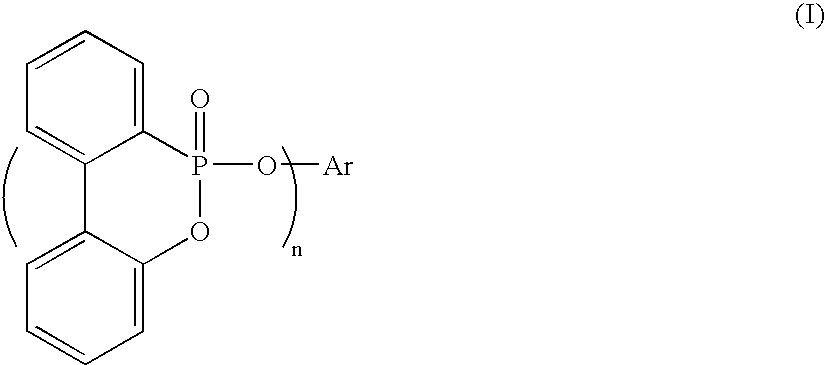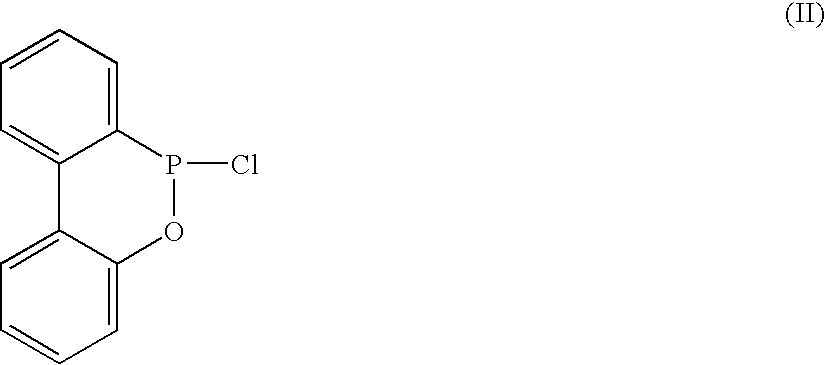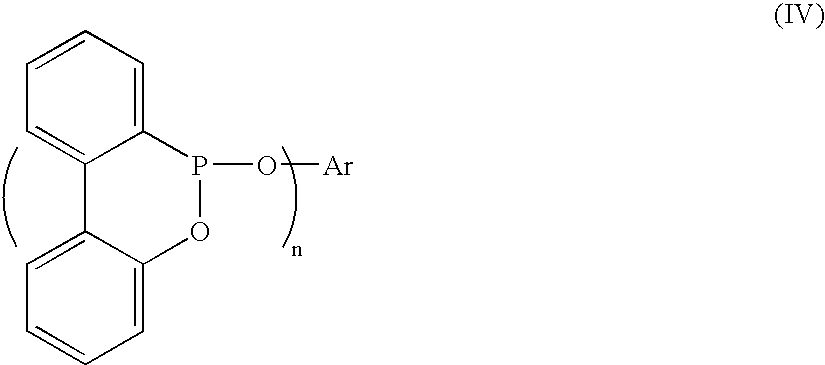Method for preparing a biphenylphosphonate compound
a technology of biphenylphosphonate and compound, which is applied in the field of preparation of biphenylphosphonate compound, can solve the problems of low selectivity and mono-condensed side products, and the downside of rdp compound, and achieve the effect of simple procedure and higher yield
- Summary
- Abstract
- Description
- Claims
- Application Information
AI Technical Summary
Benefits of technology
Problems solved by technology
Method used
Image
Examples
example 1
[0020] Add 170 g (1 mol) of o-phenylphenol, 151 g (1.1 mol) of phosphorus trichloride, and 1.36 g (0.01 mol) of zinc chloride into a 2 liter reactor, an addition funnel is set between the reactor and condenser; the condenser pumped with ice water and connected to a neutralizing flask through a air-drying tube. The reaction starts when the temperature is raised to 30° C., and is controlled at 60-80° C.; the rate of generating HCl gas would decrease after one hour, at this stage the major products are single substituded, with small amount of di-substituded product ((Ar′O)2PCl) or tri-substituded product ((Ar′O)3P); Ar′OH stands for o-phenylphenol.
[0021] At the second stage of the reaction the temperature is raised and PCl3 is then distilled into the addition funnel above the reactor; when temperature reached 110° C., add PCl3 back into the reaction slowly and heat the reaction to 180° C. for 4 hours, then reaction would stop to generate HCl gas, which shows the reaction is completed....
example 7
[0024] The method for preparing CDOP of the present example is the same as example 1; dissolve the initial product of CDOP in 500 mL of toluene, and then it is settled for 4 hours followed by filtering out the orange byproduct; obtaining 50 mL of the filtrate solution, start to inject ozone bubble into the solution at a rate of 100 ml / min for 6 hours, yellowish solution of CDOPO is then obtained and 31P NMR is used to check the sample.
EXAMPLE 8˜13
[0025] Added benzenediol and benzenetriol to the CDOPO solution obtained from example 7 according to the equivalent used in examples 1 through 6, the mixture is then heated to reflux(110-120° C.) to undergo the second stage of esterification, then nitrogen bubble is inject into the solution for 2 hours. Reaction yield is determined by 31P NMR spectrum: CPO (76.2%) RPO (81.6%) HPO (42.3%) TPO (82.4%) BPO (85.2%) PPO (36.4%)
example [UNK]
EXAMPLE 14˜19
[0026] Added benzenediol and benzenetriol to the CDOPO solution obtained from example 7 according to the equivalent used in examples 1 through 6, 1.05 mol of triethylamine is then added to the mixture at room temperature to start the esterification reaction, after stirring for 2 hours, triethylamine hydrochloride salt is filtered out. 31P NMR is used to check for completion of reaction. Then the residue is washed with 500 nm of water twice; the reaction yield is determined after removing solvent: CPO (92.5%) RPO (96.6%) HPO (75.7%) TPO (98.7%) BPO (98.5%) PPO (88.2%)
PUM
| Property | Measurement | Unit |
|---|---|---|
| temperature | aaaaa | aaaaa |
| temperature | aaaaa | aaaaa |
| temperature | aaaaa | aaaaa |
Abstract
Description
Claims
Application Information
 Login to View More
Login to View More - R&D
- Intellectual Property
- Life Sciences
- Materials
- Tech Scout
- Unparalleled Data Quality
- Higher Quality Content
- 60% Fewer Hallucinations
Browse by: Latest US Patents, China's latest patents, Technical Efficacy Thesaurus, Application Domain, Technology Topic, Popular Technical Reports.
© 2025 PatSnap. All rights reserved.Legal|Privacy policy|Modern Slavery Act Transparency Statement|Sitemap|About US| Contact US: help@patsnap.com



